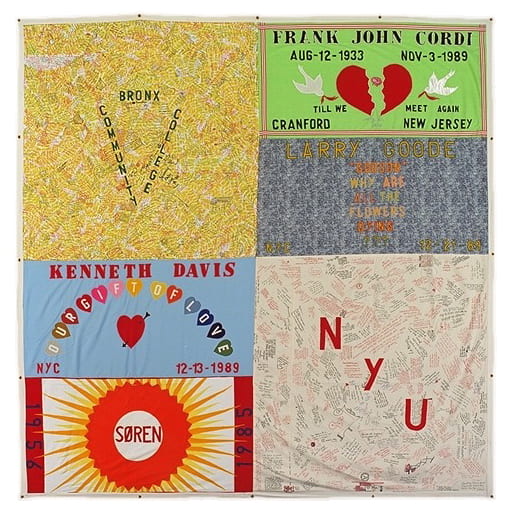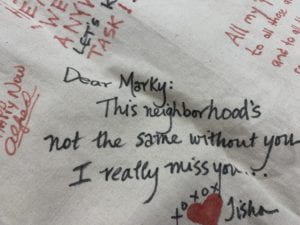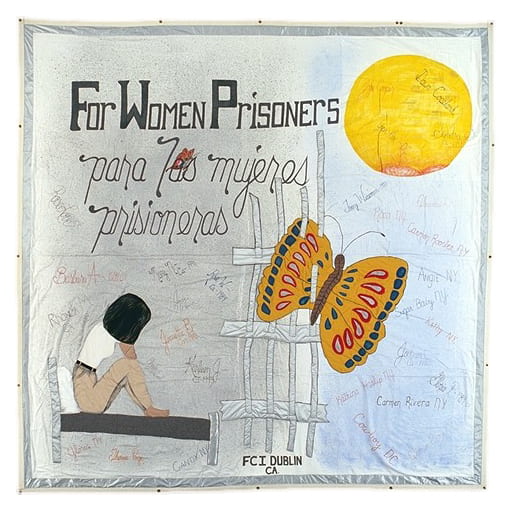Names Project AIDS Quilt panels on display at Bobst Library
 This post is authored by curators Karen Finley and Marvin J. Taylor.
This post is authored by curators Karen Finley and Marvin J. Taylor.
The NYU Libraries has installed panels from the Names Project AIDS Quilt as the final event of Stonewall@50–NYU’s year-long commemoration of the 50th anniversary of the Stonewall Riots, which launched the modern queer rights movement. The Names Project explains that how the Quilt began: “In June of 1987, a small group of strangers gathered in a San Francisco storefront to document the lives they feared history would neglect. Their goal was to create a memorial for those who had died of AIDS, and to thereby help people understand the devastating impact of the disease. This meeting of devoted friends and lovers served as the foundation of the NAMES Project AIDS Memorial Quilt. Today the Quilt is a powerful visual reminder of the AIDS pandemic. More than 48,000 individual 3-by-6-foot memorial panels—most commemorating the life of someone who has died of AIDS—have been sewn together by friends, lovers and family members.” For more information about the Quilt, go to https://www.aidsquilt.org/
These quilt pieces bear witness to our humanity, the testament of memory, and serve to archive our history. NYU is located in Greenwich Village just a few blocks from St. Vincent’s Hospital, where many AIDS patients were treated and spent their final days. The intimacy and tradition of the quilt as a symbol of comfort and warmth has a long history. The AIDS Quilts build on community and collaboration. This focus on community and collaboration has been demonstrated in quilting bees across America, the Amish quilts, the embellishment of crazy quilts, and the abstraction of the Quilts of Gee’s Bend made by African American women. Each quilt is handmade, takes time, offers close focus and is a unique document.
The AIDS crisis continues today, but from the early eighties to the late nineties it was especially hard hitting. The trauma in the US appeared on multiple levels, from the hundreds of thousands of deaths to the alignment of US policy where AIDS patients became outcasts, subject to mistreatment, stigma, and cruel disparity, driven by a public panic about HIV and homophobia. Public mourning was denied by many established religions and families refused to acknowledge relatives who died of AIDS. For many who died there was no funeral, no memorial, no dignity but instead an attempt to erase the victim’s life.
The trauma to so many, to an LGBT generation, disproportionately felt amongst African Americans and Latinos, needs to be recognized. These quilt panels were made in memory of those who died from the illness—and made by the survivors—but they also served as arts activism, as resistance, as a call to not be silent. When people died, they were not given proper burials or funerals. But friends, lovers, family, and community created this magnificent quilt and in all its glory we have a place to recognize and celebrate those who left us too soon. And we honor the creation of this archive as a creative act of agency, illumination, and witnessing—a memento mori.
We selected nine panels representing a cross section of people who we lost to AIDS. Each panel contains at least eight sections for those who are gone. Starting from the right: panel one was made by NYU to acknowledge all the people lost to the pandemic. Panel two was created to honor members of the trans community. Panel three reminds us of the men and women in prison with AIDS. Panel four contains the names of celebrities such as Keith Haring, Halston, Liberace, Perry Ellis, Rock Hudson, Robert Mapplethorpe, Freddie Mercury, Anthony Perkins, and Rudolf Nureyev. Panel five is one of several for artists from the downtown scene who were lost. This panel has sections for the performance artist Ethyl Eichelberger, African American artist Sharon Redd, and Dr. Peter Manzzoni, an early AIDS physician and activist. Panel six has a section for Cookie Mueller, actress, author, and downtown goddess. Panel seven holds a section for legendary DJ Larry Levan from Paradise Garage. He invented “house” music and is in the exhibition behind you. Panel eight includes sections for African American filmmaker Marlon Riggs and poet Essex Hemphill. Panel nine includes a section for Paul Fitz Simmons, an NYU student who did not live to see his graduation.
